Address
304 North Cardinal
St. Dorchester Center, MA 02124
Work Hours
Monday to Friday: 7AM - 7PM
Weekend: 10AM - 5PM
Address
304 North Cardinal
St. Dorchester Center, MA 02124
Work Hours
Monday to Friday: 7AM - 7PM
Weekend: 10AM - 5PM
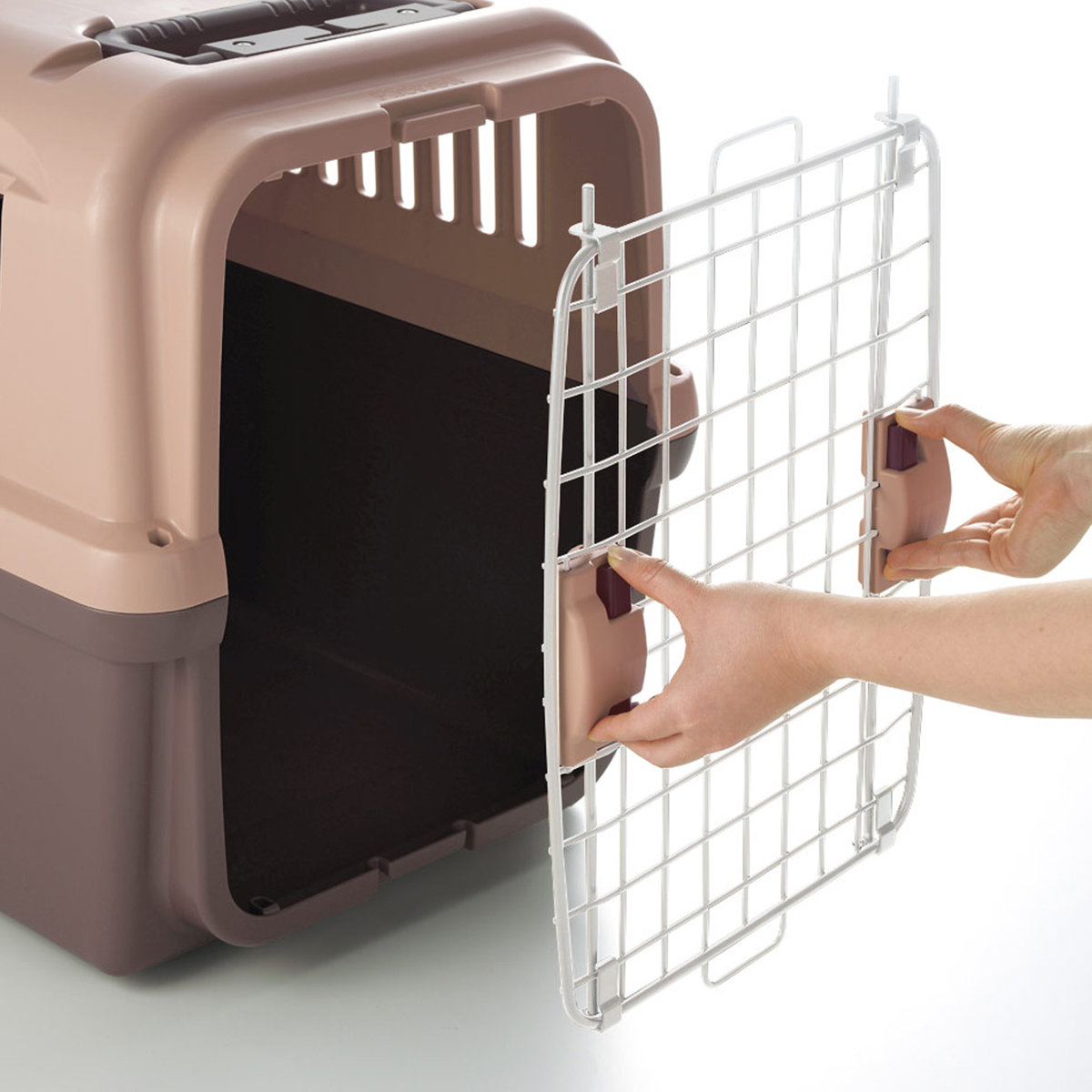
A dog crate is far more than a simple cage. For your canine companion, a crate is a safe, personal den—a sacred space that appeals to their natural, ancestral instinct to seek out a secluded and secure area. When used correctly, a dog crate is one of the most powerful and versatile tools a pet owner can have, serving as a cornerstone of training, safety, and comfort.
This comprehensive guide will walk you through every aspect of dog crates, from their history and purpose to the crucial steps of choosing, sizing, and training. Whether you have a new puppy, a seasoned adult dog, or you’re simply looking to make travel safer and less stressful, this guide will provide the answers you need.
Table of Contents
ToggleThe concept of using a crate for a dog can be misunderstood. To a human, a crate may seem like a confinement device, but to a dog, it is a den. In the wild, canines instinctively seek out small, dark, and protected spaces to rest, raise young, and feel safe from predators. A crate provides this same sense of security and privacy in a modern home. The benefits of using a crate are numerous and far-reaching:
House Training: A dog’s natural instinct is to keep their den clean. By using a crate that is appropriately sized, you can help them learn to hold their bladder and bowels for increasingly longer periods. This makes crate training one of the most effective methods for house-training.
Behavior Management: Crates are invaluable for preventing destructive behaviors when you can’t actively supervise your dog. They keep your pet safe from chewing on electrical cords, furniture, or other household dangers. This is particularly useful for puppies during their exploratory chewing phase.
Separation Anxiety: For dogs with mild separation anxiety, the crate can become a place of comfort and security. It provides a consistent, familiar space that helps them feel safe when they are left alone.
Travel and Transport: Crates are essential for safely transporting your dog. They prevent a dog from being a distraction while driving and offer protection in case of an accident. They are also required for most air travel, making a crate-trained dog an ideal travel companion.
A Safe Haven: The crate becomes your dog’s personal retreat. It’s a place they can go to escape a noisy house, get some rest, or find comfort during a thunderstorm or fireworks. This safe space is an invaluable part of their well-being.
Preparing for the Unexpected: Being comfortable in a crate can make stressful situations, like vet visits, overnight stays at a pet sitter’s, or emergency evacuations, much easier to manage for both you and your pet.
Training your dog to love their crate is a process that requires patience and positive reinforcement. The key is to never use the crate as a form of punishment. Your dog should view their crate as a welcoming den, not a jail.
Step-by-Step Dog Crate Training
Make it Positive: Once your dog is comfortable being near the crate, start placing treats and toys all the way inside. Use a happy, encouraging tone to get them to go in. Praise them enthusiastically whenever they enter.
Mealtime in the Crate: Begin feeding your dog their regular meals inside the crate. Place the food bowl all the way in the back so they have to go in completely to eat. As they get more comfortable, close the door while they’re eating, opening it as soon as they are finished. Gradually increase the time the door stays closed after their meal.
Practice Short Closures: After they’re comfortable eating inside, close the door while they’re eating. Open it as soon as they finish. Gradually increase the time the door stays closed after their meal. If they start to whine, you may be going too fast.
Increase Alone Time: Once your dog can stay in the crate quietly for about 10 minutes with you out of sight, you can begin leaving them for short periods. This could be when you run an errand or go to the store. Always give them a potty break before crating, and give them a treat or a puzzle toy to keep them occupied.
For a detailed breakdown of this training process and troubleshooting tips, see our full guide on Dog Crate Training
Whether you are going on a road trip, flying across the country, or simply visiting the veterinarian, a travel-friendly crate is a necessity. The type of crate you need depends entirely on your method of travel.
For air travel, a sturdy plastic crate is usually the only option. Airlines have strict regulations on pet carriers, and most require hard-sided kennels with specific dimensions, ventilation, and hardware. These crates are designed to withstand the rigors of airline transport and provide a secure, enclosed space that helps your dog feel safe and protected in a noisy environment.
Key Features for Air Travel: Look for crates with strong metal hardware, a secure latching door, and proper ventilation on at least three sides. You’ll also need a food and water dish that attaches to the inside of the door.
Airline Regulations: Always check the specific pet policies of your airline well in advance. They will have rules regarding the crate’s size, the type of latch, and how you label the crate for your pet’s safety.
For a complete guide to airline regulations and a list of airline-approved crates, see our full guide on Dog Crates For Travel
For car trips, a visit to a friend’s house, or a hotel stay, a portable dog crate is a convenient and lightweight option. These crates are typically made from a sturdy steel frame with a durable canvas or mesh exterior. They are designed for quick setup and take down, and most fold flat for easy storage.
Benefits of Portability: They are much lighter than plastic or wire crates, making them easy to carry. Their soft sides also make them more forgiving if a dog bumps into them in a moving vehicle.
Use Cases: They are perfect for dogs who are already crate-trained and calm. They are not recommended for chewers or dogs with separation anxiety, as the material can be easily damaged.
For a detailed look at the best portable dog crates on the market and their ideal uses, check out our guide on Portable Dog Crates.
There are several types of dog crates, each with its own benefits. The right choice for your dog depends on their size, behavior, and your lifestyle.
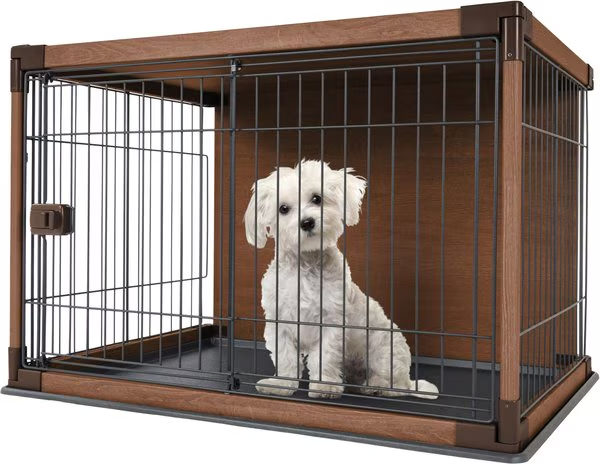
These are the most popular and versatile type of crate. They offer excellent ventilation and a clear view of the surroundings, which can help dogs feel less isolated.
Pros: Highly durable, easy to clean, and most are collapsible for storage and transport. Many come with a divider panel, making them ideal for puppy training.
Cons: The open design may not provide enough privacy for some dogs. A determined chewer can bend the wire, potentially harming their teeth.
Also known as travel kennels, these crates are excellent for travel and for dogs that prefer a more enclosed, den-like feel.
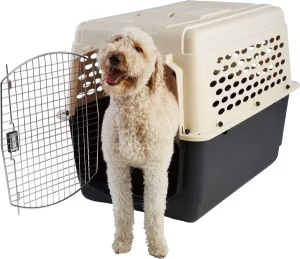
Pros: Provide a great sense of security, are easy to clean, and are generally approved for air travel.
Cons: Less ventilated than wire crates and can be bulky to store.
For a full breakdown of the pros and cons of plastic dog crates and recommendations, click here
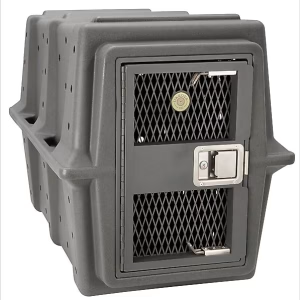
These crates are built for powerful, strong, or highly anxious dogs who can easily escape from or damage other types of crates. They are made from reinforced steel or aluminum and are incredibly secure.
Pros: Escape-proof, durable, and designed to withstand the most determined dogs.
Cons: Very heavy, not portable, and can be quite expensive.
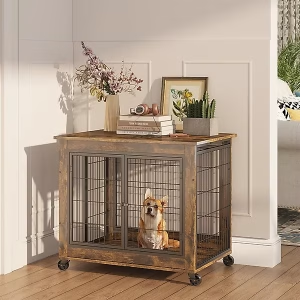
Designed to blend into your home’s decor, these crates often double as end tables or cabinets. They are aesthetically pleasing but are best for dogs who are already crate-trained and won’t chew on the furniture.
Pros: Stylish and multi-functional.
Cons: Expensive, heavy, and not suitable for destructive dogs.
This is one of the most critical steps. A crate should be a comfortable den, not a spacious apartment. A crate that is too large can encourage a puppy to use one end as a bathroom and the other as a sleeping area, which defeats the purpose of house-training.
The Crate Sizing Rule of Thumb
Your dog’s crate should be just big enough for them to:
Stand up without their head touching the top.
Turn around comfortably.
Lie down and stretch out.
To find the right size, measure your dog’s length from their nose to the base of their tail and their height from the top of their head to the ground. Add 2 to 4 inches to each measurement to ensure they have enough room.
Special Considerations for Small Dogs
While sizing is important for all dogs, dog crates for small dogs come with a few unique considerations. Small dogs have a higher risk of being crushed or injured in a large crate. Additionally, a crate that is too large can make them feel insecure and exposed. Choosing a crate specifically designed for their size ensures they feel safe and helps with effective training.
A comprehensive sizing chart and breed-specific recommendations can be found on our Dog Crate Sizing Guide
Once you have the right crate, it’s time to make it feel like a true den. The goal is to make it as comfortable and inviting as possible for your dog.
Dog Beds for Crates
A comfortable bed is essential. A soft, supportive bed will encourage your dog to see the crate as a place of comfort and rest.
Material: Look for beds made of durable, machine-washable materials. Memory foam is great for older dogs, while chew-proof fabrics are ideal for puppies.
Fit: The bed should fit snugly inside the crate, with no extra space that could tempt a puppy to have an accident.
For a curated list of the best dog beds for crates, including options for chewers and seniors, click here [Link to Content: Dog Beds for Crates].
Dog Crates and Covers
A crate cover can transform a wire crate into a cozy, private den. It blocks out light and external distractions, which can help a dog relax and feel secure.
Purpose: A cover mimics the dark, enclosed space of a natural den. It can also help with separation anxiety by limiting visual stimuli.
Types: Covers are available in various materials, from breathable canvas to blackout fabrics. Many have panels that can be rolled up for ventilation.
Learn more about the benefits and types of crate covers in our guide on [Link to Content: Dog Crates and Covers].
Whether you are looking for a first-time crate for your new puppy or a replacement for an older dog, the market is full of options. You can find everything from affordable wire crates to expensive, custom-built wooden kennels.
Pricing: Prices vary widely, from around $30 for a small, basic wire crate to over $1,000 for a luxury furniture-style crate.
Where to Buy: You can find the best dog crates at major pet supply stores, online retailers, and direct from manufacturers. Chewy has affordable dog crates for sale
For a list of the best-selling crates and tips on where to find the best deals, check out our guide on [Link to Content: Dog Crates for Sale].
Final Thoughts
A dog crate is not a place for punishment, but a tool for positive reinforcement, safety, and comfort. By understanding the psychology behind denning, choosing the right crate, and training with patience and love, you can provide your dog with a sanctuary that they will love for their entire life.
Yes, crate training a dog at night is beneficial for safety, house training, and security, as it provides a safe, den-like space and supports a consistent routine, but it must be done with the dog’s comfort in mind and for appropriate durations, not exceeding 8-9 hours for adult dogs
You generally should not leave a well-adjusted adult dog alone in a crate overnight for more than 6-8 hours, and puppies should not be left in a crate overnight for that long, as it can cause discomfort, anxiety, or issues with their ability to control their bladder and bowels.
Caged dog syndrome describes the physical and psychological effects on a dog due to prolonged confinement in a crate or kennel, leading to symptoms like depression, anxiety, aggression, withdrawal, or destructive behaviors.
There isn’t one “best” dog crate; the ideal choice depends on your dog’s needs, such as safety, travel, anxiety, or aesthetics.